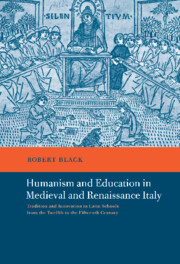 Humanism and Education in Medieval and Renaissance Italy
Humanism and Education in Medieval and Renaissance Italy Book contents
- Frontmatter
- Contents
- Acknowledgements
- List of abbreviations
- Editorial note regarding citations from manuscripts and publications
- A note on chronological terminology
- Introduction
- 1 Italian Renaissance education: an historiographical perspective
- 2 The elementary school curriculum in medieval and Renaissance Italy: traditional methods and developing texts
- 3 The secondary grammar curriculum
- 4 Latin authors in medieval and Renaissance Italian schools: the story of a canon
- 5 Reading Latin authors in medieval and Renaissance Italian schools
- 6 Rhetoric and style in the school grammar syllabus
- Conclusion
- Appendix I BL Harley 2653: the earliest known manuscript of Ianua
- APPENDIX II A handlist of manuscripts of Ianua
- Appendix III Manuscripts of Tebaldo's Regule
- Appendix IV Handlist of manuscripts of school authors produced in Italy and now found in Florentine libraries
- Appendix V Theoretical grammar manuscripts in Florentine libraries examined and included or eliminated as italian school grammars
- Appendix VI Authorities Cited Explicitly in Manuscripts of Major School Authors in Florentine Libraries
- Bibliography
- Index of manuscripts
- General index
5 - Reading Latin authors in medieval and Renaissance Italian schools
Published online by Cambridge University Press: 25 July 2009
- Frontmatter
- Contents
- Acknowledgements
- List of abbreviations
- Editorial note regarding citations from manuscripts and publications
- A note on chronological terminology
- Introduction
- 1 Italian Renaissance education: an historiographical perspective
- 2 The elementary school curriculum in medieval and Renaissance Italy: traditional methods and developing texts
- 3 The secondary grammar curriculum
- 4 Latin authors in medieval and Renaissance Italian schools: the story of a canon
- 5 Reading Latin authors in medieval and Renaissance Italian schools
- 6 Rhetoric and style in the school grammar syllabus
- Conclusion
- Appendix I BL Harley 2653: the earliest known manuscript of Ianua
- APPENDIX II A handlist of manuscripts of Ianua
- Appendix III Manuscripts of Tebaldo's Regule
- Appendix IV Handlist of manuscripts of school authors produced in Italy and now found in Florentine libraries
- Appendix V Theoretical grammar manuscripts in Florentine libraries examined and included or eliminated as italian school grammars
- Appendix VI Authorities Cited Explicitly in Manuscripts of Major School Authors in Florentine Libraries
- Bibliography
- Index of manuscripts
- General index
Summary
In the preceding three chapters, this book's approach has been chronological, reflecting the significant developments in elementary and secondary education occurring in Italian schools from the twelfth to the fifteenth century. In this chapter, on the other hand, the treatment will be topical: the fact is that methods of reading and using school authors hardly changed over this long period. Simple philology (e.g. paraphrase, grammar, figures, word-order, geography, history, mythology, elementary rhetorical analysis) remained pupils' habitual fare. Even the use of the vernacular as an aid for learning Latin, after its introduction into Italian education during the Duecento, showed little significant development in succeeding centuries. Only in one or two marginal areas (for example, the new preoccupation with verse analysis in the fifteenth century) was there any sign of innovation in the approach to the authors.
Another important feature of school reading throughout this period is the overwhelming dominance of basic philology. Morals and philosophy make an occasional appearance, but invariably such comments are lost in an immense ocean of philological minutiae. There was no new preoccupation with the nitty-gritty of philology in the Italian Renaissance classroom: this had been the staple fare of medieval schools too.
GLOSSING BETWEEN THE LINES: THE STRUGGLING PUPIL
The role of the vernacular
Although often well advanced in Latin, pupils reading the authors in the grammar schoolroom still glossed their texts in the vernacular, as is evident from a number of manuscripts signed by pupils in schools.
- Type
- Chapter
- Information
- Humanism and Education in Medieval and Renaissance ItalyTradition and Innovation in Latin Schools from the Twelfth to the Fifteenth Century, pp. 275 - 330Publisher: Cambridge University PressPrint publication year: 2001
- 1
- Cited by
